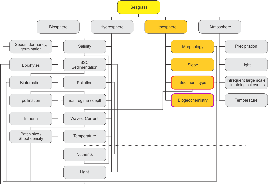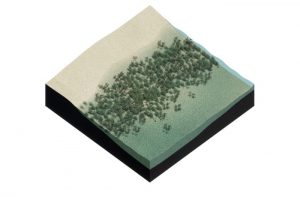Lithosphere (solid materials, soil and rocks) – seagrass

Morphology: The morphology of an embayment or other potential seagrass locations plays a role in determining limiting or favouring hydrodynamic conditions related to nutrient fluxes and sediment dynamics. Similarly, the morphodynamics may determine whether a location is favourable or morphologically too variable for seagrass establishment.
Slope: Seagrasses usually do not occupy steeply sloping coastal zones in large densities. This is probably related to the angle of light incidence and seagrass growth strategies.
Sediment type: Sediment grain size and properties (mineral or organic; cohesive or non-cohesive) play a role in settlement possibilities, rooting, aeration, sediment nutrient availability (diffusion), resuspension (erosion, turbidity) and biogeochemical processes. Sediment characteristics are usually more critical for initial seagrass settlement than for the development of existing (healthy) seagrass beds.
Biogeochemisty: Organic C, Phosphate, Ammonium, Nitrate, Ph, Redox, Oxygen, microbial activity, Sulphate, Sulphide, Ferric (Fe3+) and ferrous (Fe2+) Iron are important biogeochemical factors.
The ability to maintain a positive net carbon balance over time determines the survival of seagrass. Large respiratory demands are involved in maintaining a large heterotrophic biomass (roots, rhizomes). Enabling colonization of sulphate-rich submerged anoxic sediments requires a large amount of energy. Seagrass is able to grow on anoxic soils, and due to the high energy required, this is what explains why seagrasses are amongst the flowering plants with the highest light requirements.
In the sulphate-rich marine environment, sulphide toxicity is a major threat. Important aspects in this respect are:
- Sediment particle size
- Sediment organic content
- Sediment carbonate content
- Redox
- Fe3+, phosphate, sulphate and inorganic-N concentrations
- Temperature.
In healthy seagrass beds there is a delicate balance between biogeochemical processes preventing sulphide toxicity. This balance may be disturbed when light availability decreases, when the input of organic matter and nutrients changes or when sediment type is altered. Seagrasses transport oxygen, which is produced by photosynthesis under the influence of light, into the rhizosphere, keeping redox levels high. The extent to which the rhizosphere may be oxygenated depends on the rate of photosynthesis, sediment porosity (particle size) and microbial and chemical oxygen demand. Microbial activity is directly related to organic substrate, temperature and the availability of electron acceptors.
The most important electron acceptors in this respect are, in order of preference: oxygen, nitrate, Fe3+ and sulphate. The higher the organic content and microbial activity, the larger the demand for electron acceptors and the probability of sulphide production. Nitrate is formed by an oxygen-consuming process of nitrification. Ammonium needed for nitrification may result from microbial mineralisation of organic matter or from nitrogen fixation by sulphate reducing bacteria. Ferrous iron is formed from ferric iron and binds with sulphide leading to insoluble black iron sulphide, thus reducing sulphide toxicity. However, phosphate also reacts with iron and depending on its concentration may prevent the formation of Fe2+. In carbonate sediments, phosphate in its turn is bound the calcium carbonate. This illustrates the complexity of biogeochemistry.
As for nutrient concentration, the amount of organic matter present is not necessarily related to the amount available for the microbial community. A tight coupling between organic matter input and fast microbial decomposition of organic matter (expedited by high temperature) may result in low organic matter contents and high sulphide levels. In general, sufficient aeration of the sediment (biologically by bioturbation or photosynthesis; mechanically by wave- and current-induced pressure variations) in balance with organic matter availability and microbial activity leads to healthy conditions for seagrass settlement and development.

